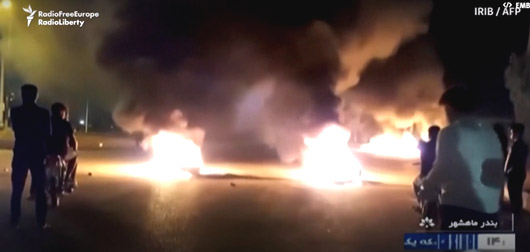by WorldTribune Staff, December 3, 2019
As its officials shot protesters dead to suppress anti-government protests which erupted last month, the Iranian regime also imposed a near-total Internet blackout to keep news of what was happening from getting out.
NetBlocks, which monitors worldwide Internet access, said that as the protests spread on Nov. 19, connectivity in Iran had fallen to just 4 percent of ordinary levels, meaning nearly every Iranian was unable to go online.

But journalists and citizens who witnessed the deadly crackdown have been able in recent days to describe what went down in the Islamic Republic.
Security forces were perched on the roofs of government buildings and shooting at protesters. A journalist said his young cousin died after being shot in the forehead.
Amnesty International said it was “horrified” that so many protesters had been killed.
“We’re alarmed that authorities have shut down the Internet to create an information blackout of their brutal crackdown. We’re investigating,” the rights group said on Nov. 18.
The little news that has come out of Iran also shows that the protests, which were sparked by citizens’ objections to an increase in gas prices, escalated to full on anger at the Iranian regime of supreme leader Ayatollah Ali Khamenei.
According to a report by Radio Free Europe/Radio Liberty (RFE/RL), first-hand accounts detail how some of the protesters targeted the clerical establishment with slogans including chants of “Mullahs get lost,” “Death to Khamenei,” and “We do not want the Islamic Republic.” Posters of Khamenei or symbols associated with Iran’s supreme leader were also spotted being set on fire.
Teheran-based journalist Hassan Fathi told RFE/RL that there’s a deep “mistrust” between Iranians and their government, as a result he said many don’t believe officials’ comments that proceeds from the new gas price hike will be used to provide additional subsidies for 60 million people living in low-income families.
Saeed Bashirtash, a Brussels-based political activist, said many Iranians are angered by the establishment’s “inefficacy,” therefore suggesting the protests are likely to continue.
“I don’t think these protests will stop; there could be a pause, but we’re likely to see more protests every few months or every one or two years,” Bashirtash told RFE/RL’s Radio Farda, adding that the establishment is likely to be more and more “worn out.”
“People believe that this establishment is not capable of running the country,” he said.
Ali Vaez, the director of the Iran Project at the International Crisis Group (ICG), said on Twitter that “the speed with which the [Iranian] leadership brought down its iron fist first indicates that it sees itself under siege [not just internally, but also regionally] & so it will brook no dissent.”
Vaez added that the protests could lead both the Iranian establishment and the administration of U.S. President Donald Trump to dig in on their conflicting policies.
“Teheran, by seeing concessions as tantamount to weakness, and Washington by taking unrest as evidence [that its] max pressure policy could undermine or perhaps even collapse the Iranian government,” Vaez said on Twitter on November 18.
There was also loud criticism of Iran’s support for its allies in the region, including Syrian President Bashar Assad and the Houthi rebels in Yemen, the report said.
Journalists and observers who managed to get online as protests raged on Nov. 18 and 19 described a heavy security presence in some areas in the capital, Teheran, with one saying that “I passed through east Teheran and saw as many burnt-out banks as I had seen in my entire life.”
The witnesses said Iran’s regime deployed riot police and fighters for the elite Islamic Revolutionary Guards Corps (IRGC) to quell the protests.
Security forces reportedly not only used tear gas to disperse protesters, but photos and video which made it past the blackout show live ammunition being used against demonstrators.
A journalist in Teheran said on Twitter that his cousin was among those killed. “He said his relative was a young man who was fed up with state oppression and was shot in the forehead by security forces in Behbahan,” the RFE/RL report said.
Journalist Mohammad Mosaed, who managed to get online amid the shutdown, said on Twitter that he had used 42 different proxy sites to write a tweet.
“Knock knock! Hello Free World! I used 42 different [proxy sites] to write this! Millions of Iranians don’t have [I]nternet. Can you hear us?” he wrote with the hashtag #Internet4Iran that Iranians have been using to protest the blackout.
Intelligence Brief __________ Replace The Media
